Study on Mechanical Properties of the Basalt Fiber-Rubber Granular Concrete under Triaxial Stress Condition and Its Application
Abstract
:1. Introduction
2. Compression Tests
2.1. Test Device and Main Materials
2.2. Ratio Design
2.3. Triaxial Test Results
3. Numerical Simulation Results
- 1.
- All the rock materials were assumed to be homogeneous and isotropic;
- 2.
- The mean buried depth for the deeply buried roadways was generally over 800 m; thus, the self-weight of rocks was considered as the vertical stress on the model, and the lateral pressure coefficient was used to simulate the horizontal tectonic force;
- 3.
- The influence of groundwater was not considered.
3.1. The Engineering Overview
- 1.
- High-strength prestressed bolted: diameter and length were 22 mm and 2400 mm, respectively; anchorage length ≥1000 mm; anchorage force ≥150 kN; initial anchorage force ≥50 kN; row spacing and column spacing were 800 mm and 500 mm, respectively.
- 2.
- Plain concrete: the strength and average thickness of concrete were C40 and 400 mm, respectively.
3.2. Numerical Model Setup
3.3. Realization of Strain-Softening
3.4. Analysis of Numerical Results
3.4.1. Plastic Zone Analysis
3.4.2. Displacement Analysis
4. Conclusions
- 1.
- The maximal yield strength of the BFRGC under triaxial compression tests is obtained when the mass fraction of basalt fiber in BFRGC is 0.4%. Additionally, basalt fiber can inhibit the development of fractures in plain concrete and rubber concrete, and mixing rubber particles into plain concrete can also inhibit the development of fractures of concrete.
- 2.
- Compared with the stress–strain curves of plain concrete under triaxial compression tests, the decreasing trend of BFRGC after the peak strength is increasing gentle, it is illustrated that the BFRGC has a good post-peak performance.
- 3.
- The optimum contents of basalt fibers and rubber particles in BFRGC are 0.4% and 5–10%, respectively, and the BFRGC with optimum ratios can effectively reduce the plastic region in surrounding rock of roadways and deformation of the rigid supporting structures. It may provide technical guidance for the support of deeply buried high-stress soft rock roadways.
- 4.
- The slight difference of the deformations among different supporting ways obtained by the finite difference method is partially due to the small support thickness of concrete. It is expected that the difference will be greater and that the advantage of the BFRGC with optimum proportions will become more obvious if the support thickness is increased.
Author Contributions
Funding
Conflicts of Interest
Appendix A
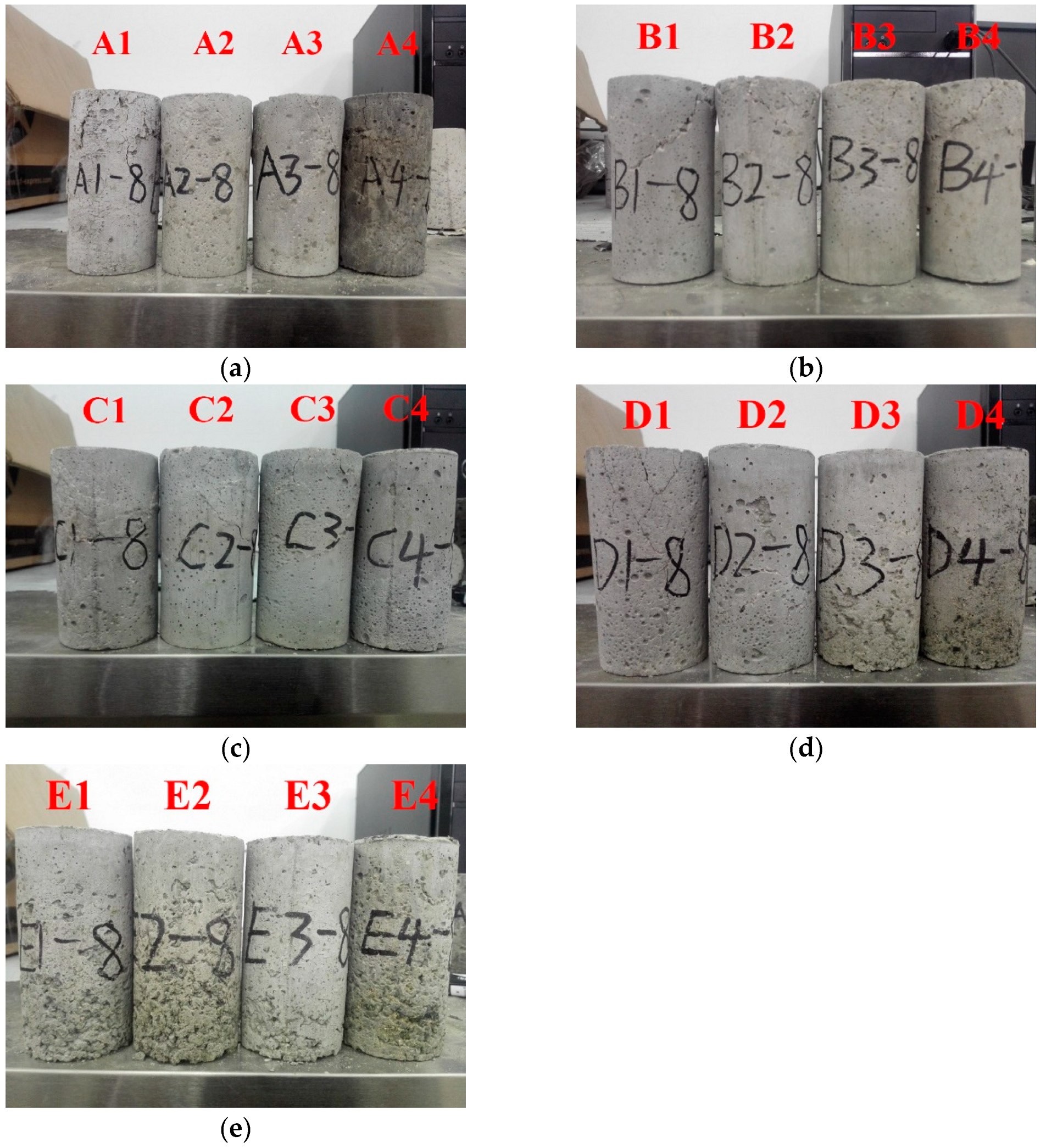
References
- Jiang, Y.D.; Pan, Y.S.; Jiang, F.X.; Don, L.M. State of the art review on mechanism and prevention of coal bumps in China. J. China Coal Soc. 2014, 39, 205–213. [Google Scholar] [CrossRef]
- He, M.C.; Xie, H.P.; Peng, S.P. Study on rock mechanics in deep mining engineering. Chin. J. Rock Mech. Eng. 2005, 24, 2803–2813. [Google Scholar] [CrossRef]
- Xie, H.P.; Gao, F.; Ju, Y. Research and development of rock mechanics in deep ground engineering. Chin. J. Rock Mech. Eng. 2015, 34, 2161–2178. [Google Scholar] [CrossRef]
- Hu, Z.Q.; Xiao, W.; Wang, P.J.; Zhao, Y.L. Concurrent mining and reclamation for underground coal mining. J. China Coal Soc. 2013, 38, 301–307. [Google Scholar] [CrossRef]
- Zhou, Y. Research on Hongmiao mine united timbering of soft rock coal roadway under high stress. Master’s Thesis, Liaoning Technical University, Fuxin, Liaoning, China, 2005. [Google Scholar]
- Hu, S.R.; Peng, J.C.; Huang, C.; Can, P.; Li, M. An overview of current status and progress in coal mining of the deep over a kilometer. J. China Coal Soc. 2011, 20, 105–110. [Google Scholar] [CrossRef]
- Vogel, M.; Rast, H.P. AlpTransit-safety in construction as a challenge: Health and safety aspects in very deep tunnel construction. Tunn. Undergr. Space Technol. 2000, 15, 481–484. [Google Scholar] [CrossRef]
- Gao, M.S.; He, Y.L.; Lu, C.P. Coordination mechanism of internal strong active support, soft structure pressure relief and anti-punching of roadway. J. China Coal Soc. 2020, 45, 2749–2759. [Google Scholar] [CrossRef]
- Yu, F.H.; Zhao, T.B.; Tan, Y.L.; Guo, W. Study on quantitative calculation method of mining roadway supporting intensity under depressurized mining. J. Min. Saf. Eng. 2016, 33, 460–466. [Google Scholar] [CrossRef]
- He, M.C.; Li, C.; Gong, W.L.; Jiang, C. Support principles of NPR bolts /cables and control techniques of large deformation. Chin. J. Rock Mech. Eng. 2016, 35, 1513–1529. [Google Scholar] [CrossRef]
- Kaewunruen, S.; Li, D.; Chen, Y.; Xiang, Z. Enhancement of dynamic damping in eco -friendly railway concrete sleepers using waste-tyre crumb rubber. Materials 2018, 11, 1169. [Google Scholar] [CrossRef] [Green Version]
- Cao, G.R.; Wang, J.; Qing, L.B.; Yang, Z. Experimental study on the fracture characteristics of crumb rubber concrete. J. Civ. Archit. Environ. Eng. 2018, 40, 91–97. [Google Scholar] [CrossRef]
- Al-Tayeb, M.M.; Abu Bakar, B.H.; Ismail, H.; Md Akil, H. Effect of partial replacement of sand by recycled fine crumb rubber on the performance of hybrid rubberized-normal concrete under impact load: Experiment and simulation. J. Clean. Prod. 2013, 59, 284–289. [Google Scholar] [CrossRef]
- Atahan, A.O.; Yücel, A.Ö. Crumb rubber in concrete: Static and dynamic evaluation. Constr. Build. Mater. 2012, 36, 617–622. [Google Scholar] [CrossRef]
- Ganesan, N.; Bharati Raj, J.; Shashikala, A.P. Flexural fatigue behavior of self-compacting rubberized concrete. Constr. Build. Mater. 2013, 44, 7–14. [Google Scholar] [CrossRef]
- Grinys, A.; Sivilevičius, H.; Pupeikis, D.; Ivanauskas, E. Fracture of concrete containing crumb rubber. J. Civ. Eng. Manag. 2013, 19, 447–455. [Google Scholar] [CrossRef] [Green Version]
- Gupta, T.; Chaudhary, S.; Sharma, R.K. Assessment of mechanical and durability properties of concrete containing waste rubber tire as fine aggregate. Constr. Build. Mater. 2014, 73, 562–574. [Google Scholar] [CrossRef]
- Sukontasukkul, P.; Chaikaew, C. Properties of concrete pedestrian block mixed with crumb rubber. Constr. Build. Mater. 2006, 20, 450–457. [Google Scholar] [CrossRef]
- Li, Z.C.; Xu, J.Y.; Luo, X.; Fan, J.S.; Miao, H.D. Experimental study on the basic mechanical properties of rubber powder concrete. Bull. Chin. Ceram. Soc. 2013, 32, 2589–2594. [Google Scholar] [CrossRef]
- Xu, Y.; Bu, J.W.; Liu, Y.X.; Xu, Y.C. Fracture behaviors of rubber concrete under cyclic loading. J. Civ. Environ. Eng. 2020. [Google Scholar] [CrossRef]
- Mohammed, B.S.; Adamu, M.; Shafiq, N. A Review on the Effect of Crumb Rubber on the Properties of Rubbercrete. Int. J. Civ. Eng. Technol. 2017, 8, 599–615. Available online: http://www.iaeme.com/IJCIET/issues.asp?JType=IJCIET&VType=8&IType=9 (accessed on 15 September 2020).
- Thomas, B.S.; Gupta, R.C.; Panicker, V.J. Recycling of waste tire rubber as aggregate in concrete: Durability-related performance. J. Clean. Prod. 2016, 112, 504–513. [Google Scholar] [CrossRef]
- Richardson, A.; Coventry, K.; Edmondson, V.; Dias, E. Crumb rubber used in concrete to provide freeze-thaw protection (optimal particle size). J. Clean. Prod. 2016, 112, 599–606. [Google Scholar] [CrossRef]
- Ataei, H. Experimental study of rubber tire aggregates effect on compressive and dynamic load-bearing properties of cylindrical concrete specimens. J. Mater. Cycles Waste Manag. 2016, 18, 665–676. [Google Scholar] [CrossRef]
- Ramírez, C.P.; Merino, M.D.R.; Arrebola, C.V.; Barriguete, A.V.; Kosior-Kazberuk, M. Analysis of the mechanical behaviour of the cement mortars with additives of mineral wool fibres from recycling of CDW. Constr. Build. Mater. 2019, 210, 56–62. [Google Scholar] [CrossRef]
- Wu, Y.; Song, W.; Zhao, W.; Tan, X. An experimental study on dynamic mechanical properties of Fiber-Reinforced concrete under different strain rates. Appl. Sci. 2018, 8, 1904. [Google Scholar] [CrossRef] [Green Version]
- Qin, J.-L.; Qiao, W.-G.; Lin, D.-G.; Zhang, S.; Wang, J.-Y. Mechanical Properties and Numerical Analyses of Basalt Fiber Crumb Rubber Mortars in Soft Rock Roadways. Adv. Civ. Eng. 2019, 2019, 1–13. [Google Scholar] [CrossRef] [Green Version]
- Gao, Y. Study on basic mechanical properties of basalt fiber recycled concrete. Master’s Thesis, Anhui University of Science and Technology, Huainan, Anhui, China, 2018. [Google Scholar]
- Lin, X.S.; Yang, G.L. Steel Fiber High-Strength and Ultra-High-Strength Concrete; Science Press: Beijing, China, 2002; pp. 27–35. [Google Scholar]
- Xu, G.C.; Bai, H.C.; Zheng, Y.R.; Liu, C. Supporting Structure of Underground Engineering; China Water Resource Hydropower Press: Beijing, China, 2002. [Google Scholar]
- Voisin, C.; Ionescu, I.; Campillo, M. Crack growth resistance and dynamic rupture arrest under slip-dependent friction. Phys. Earth Planet. Inter. 2002, 131, 279–294. [Google Scholar] [CrossRef]
- Ampuero, J.-P.; Vilotte, J.-P.; Sa´nchez-Sesma, F.J. Nucleation of rupture under slip dependent friction law: Simple models of fault zone. J. Geophys. Res. 2002, 107. [Google Scholar] [CrossRef] [Green Version]
- Li, W.T.; Li, S.C.; Feng, X.D.; Li, S.C.; Yuan, C. Study of post-peak strain softening mechanical properties of rock based on Mohr-Coulomb criterion. Chin. J. Rock Mech. Eng. 2011, 30, 1460–1466. [Google Scholar]

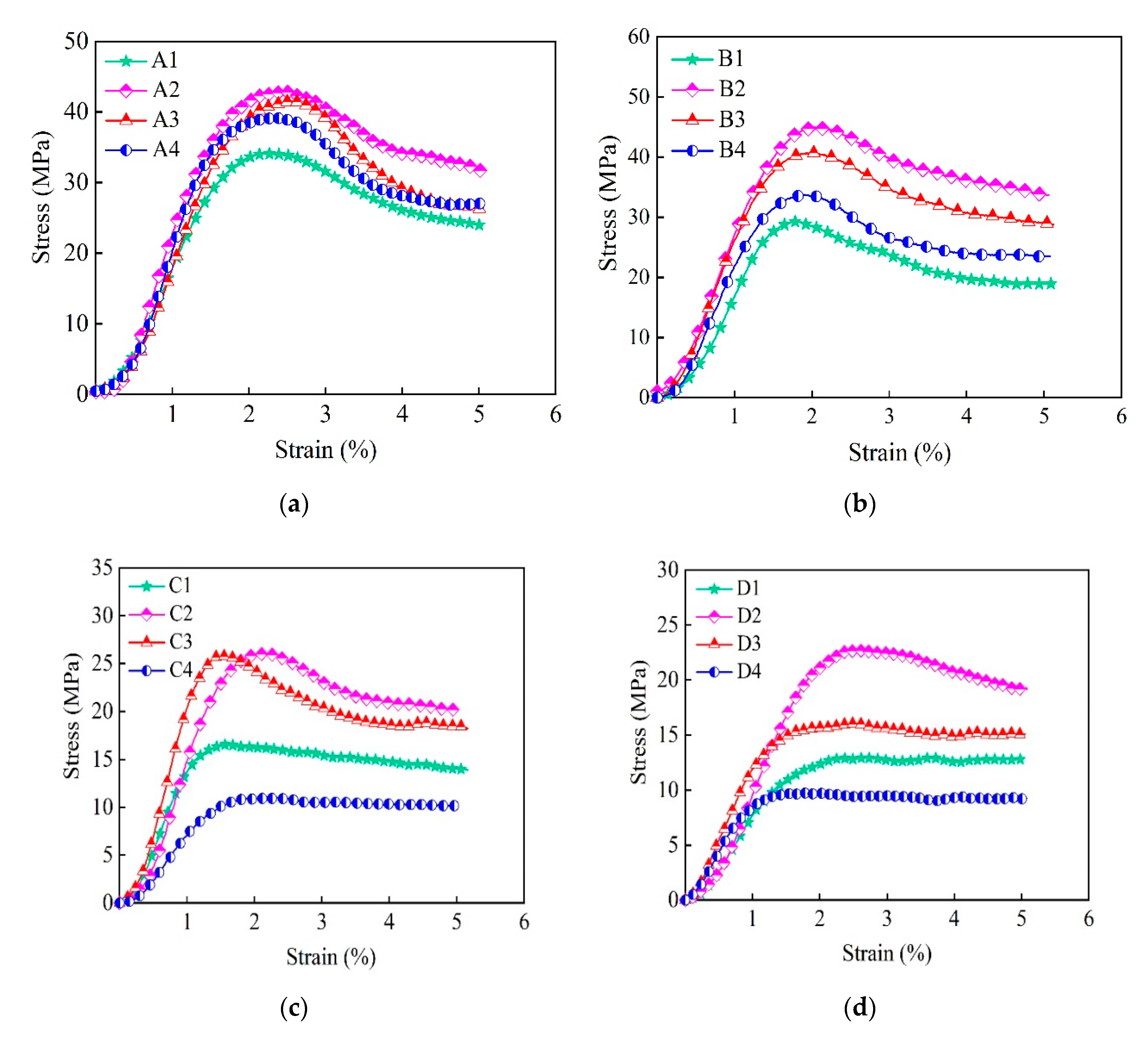
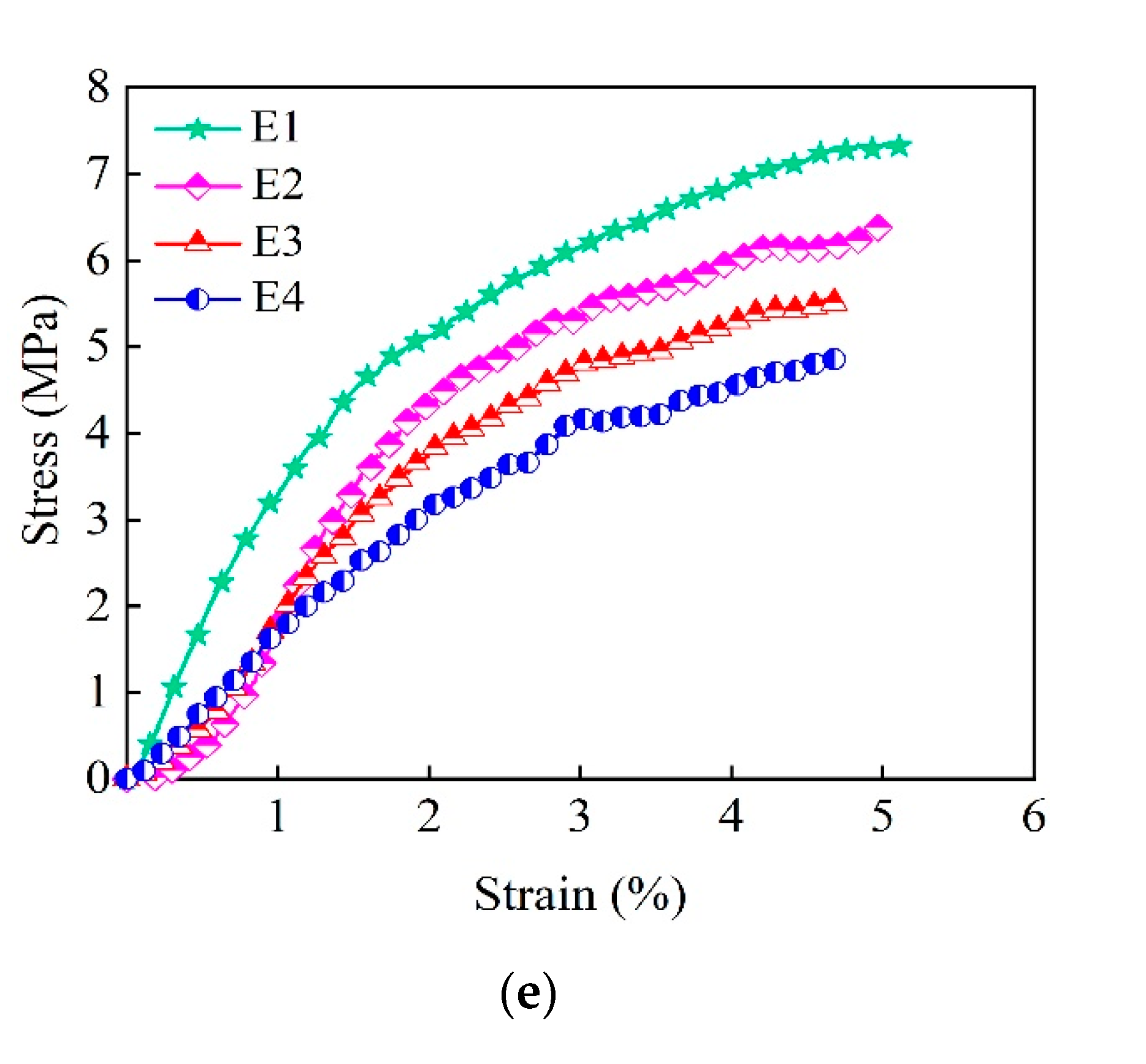

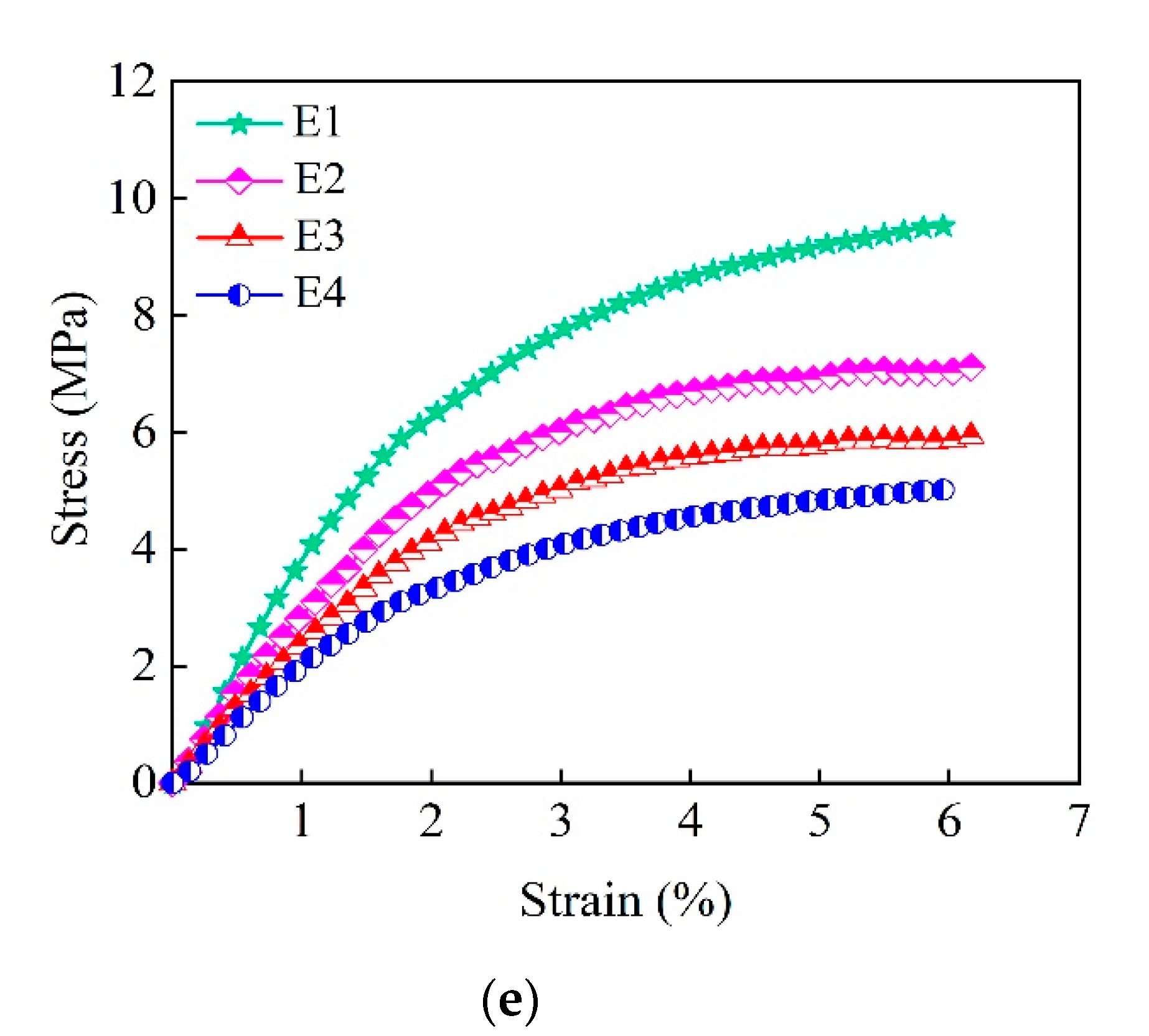
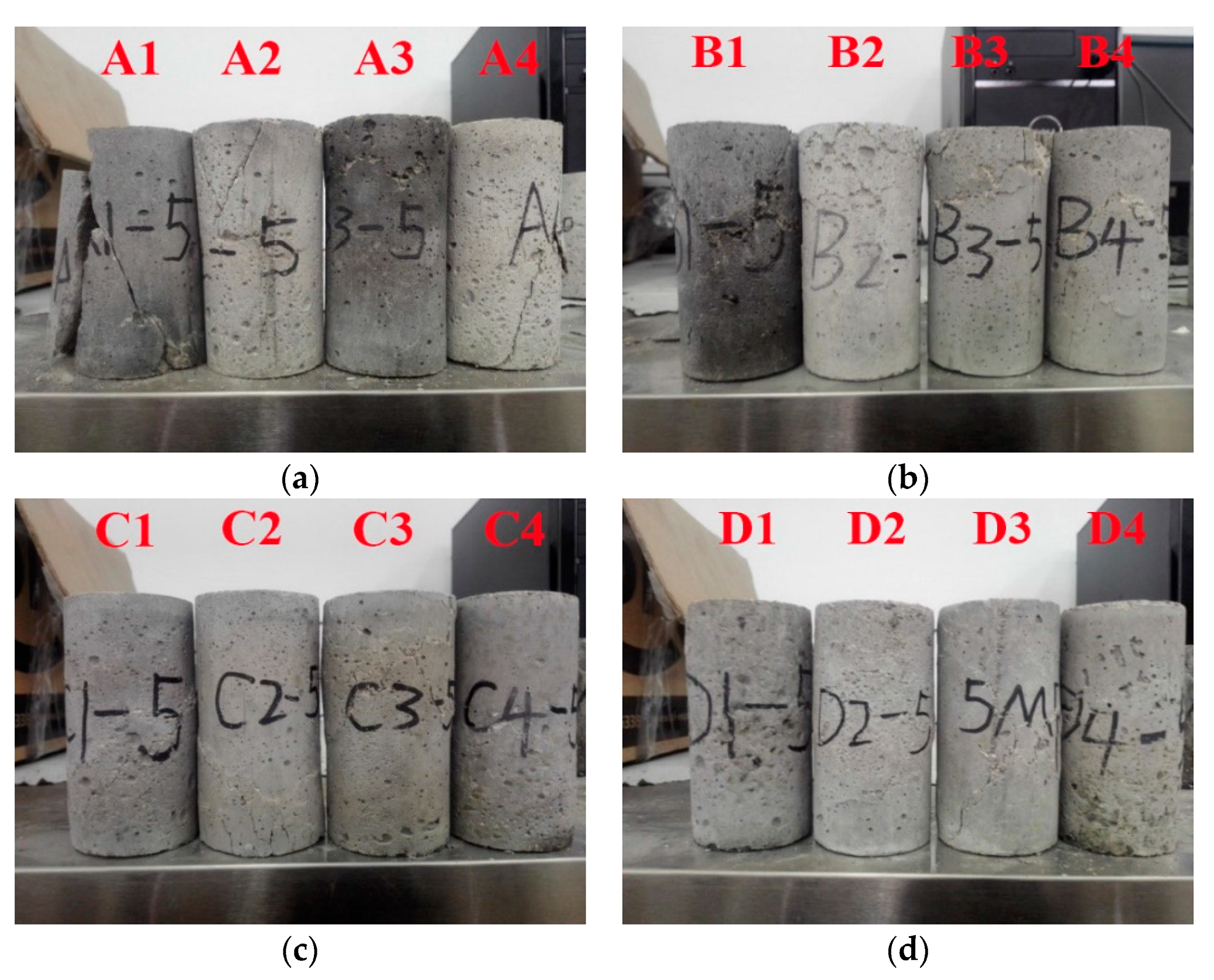
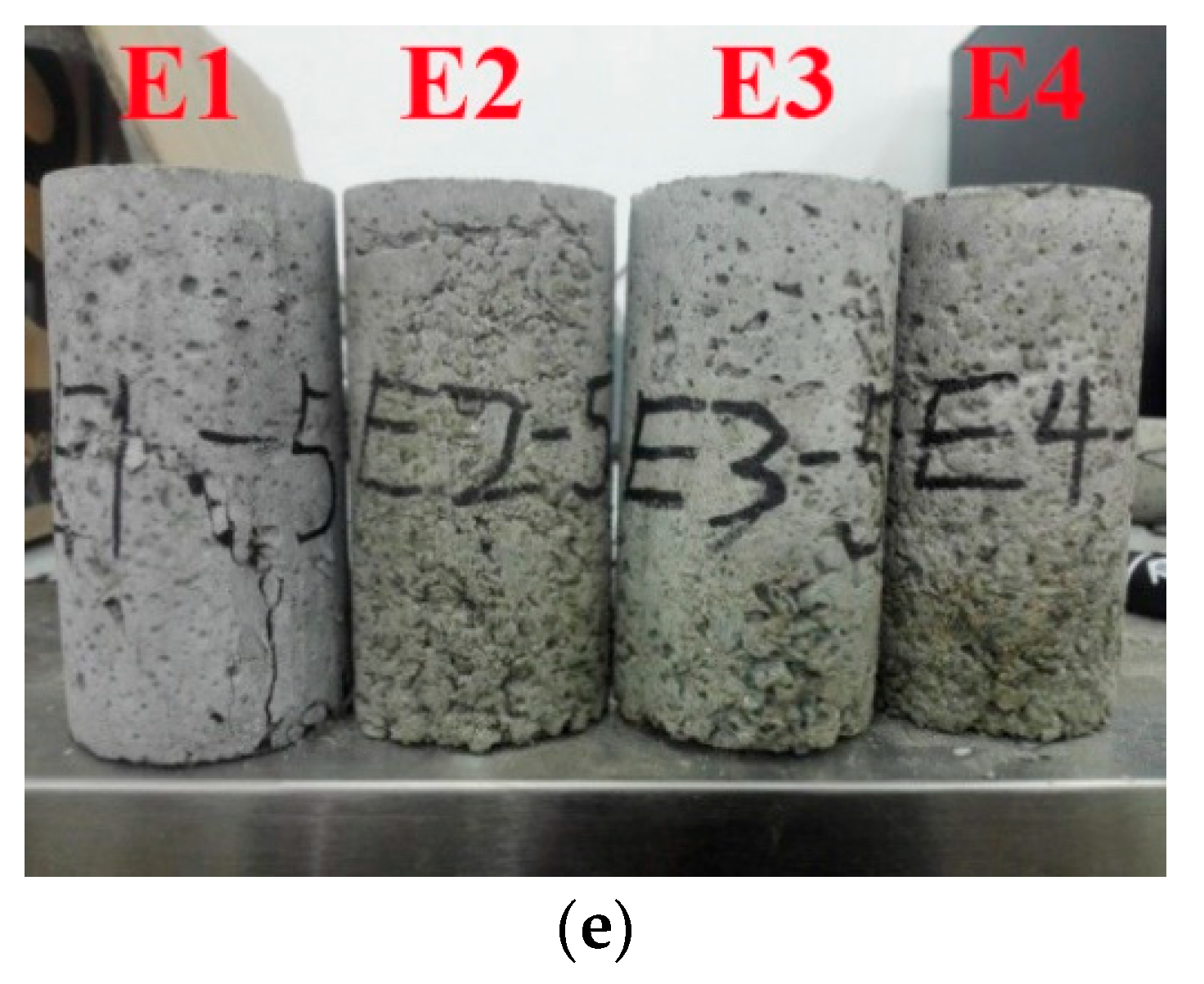
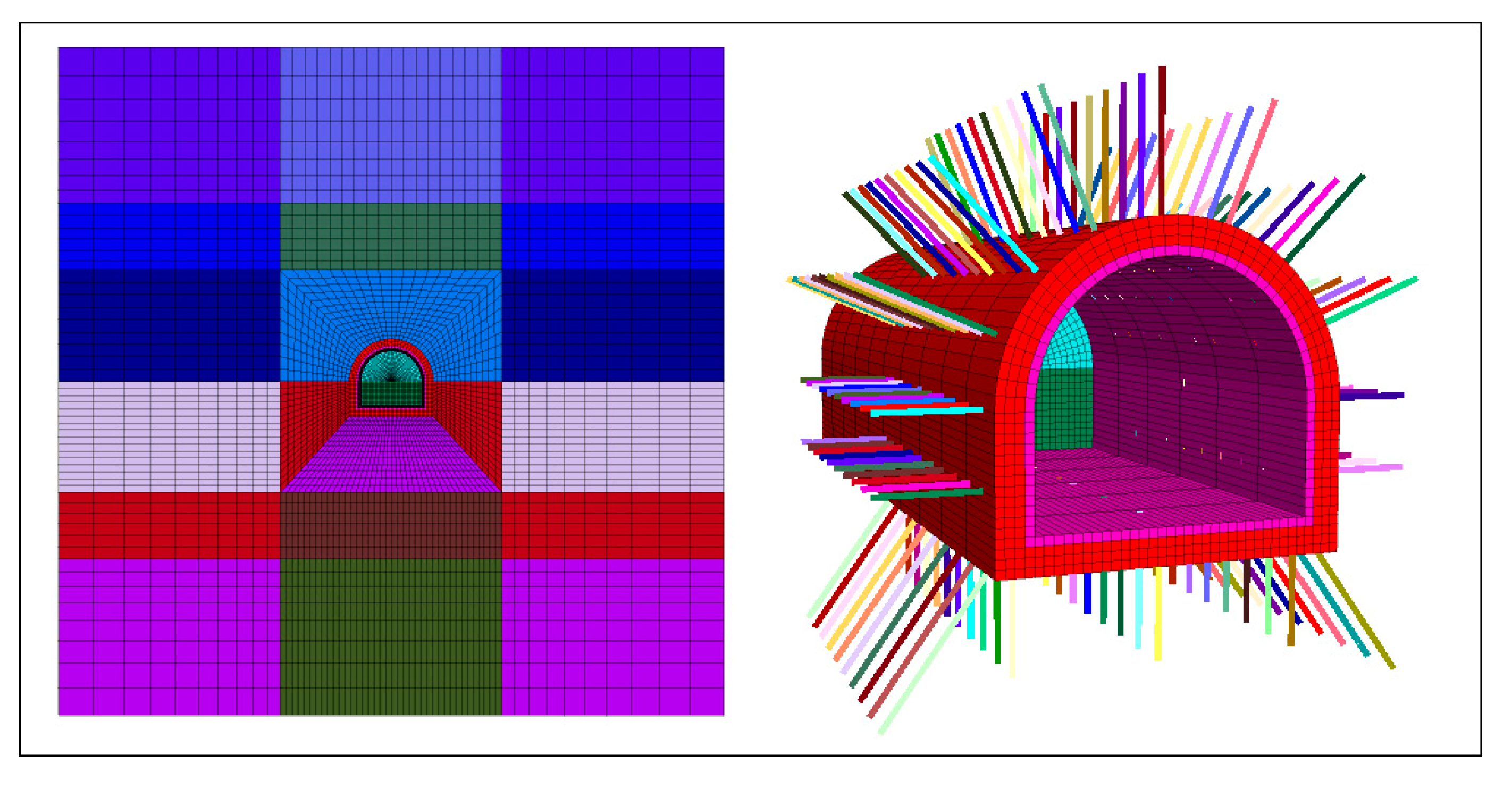
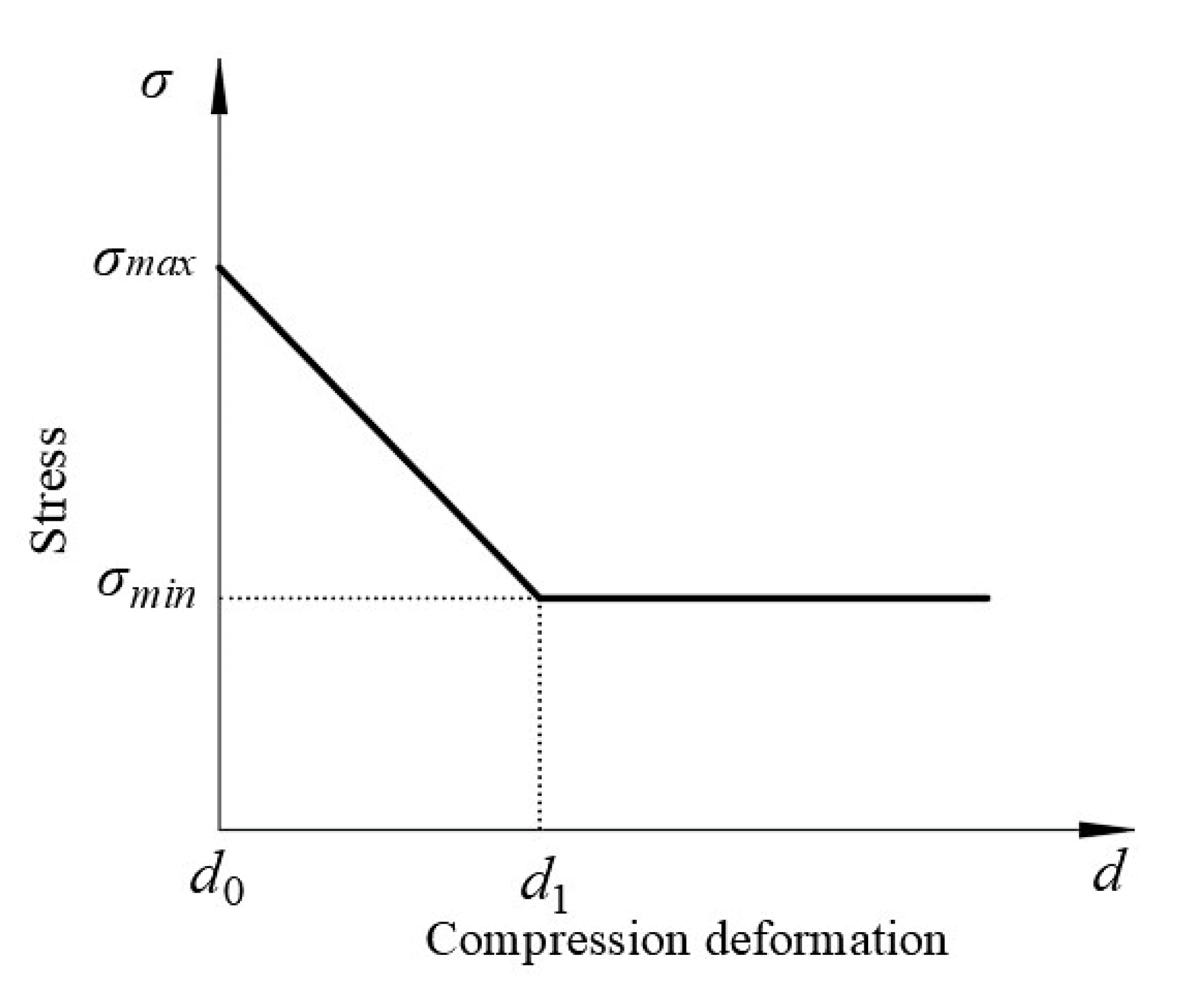
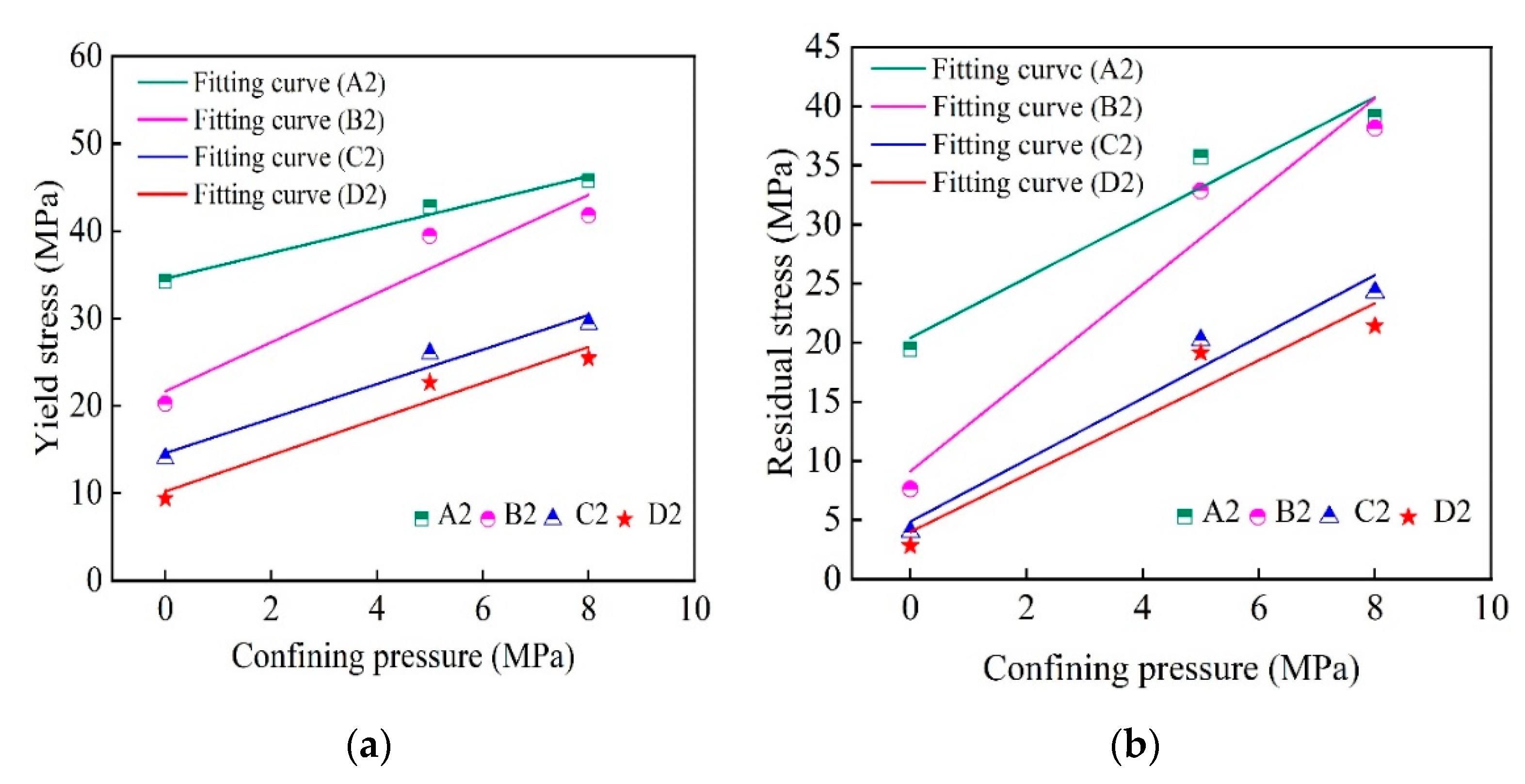

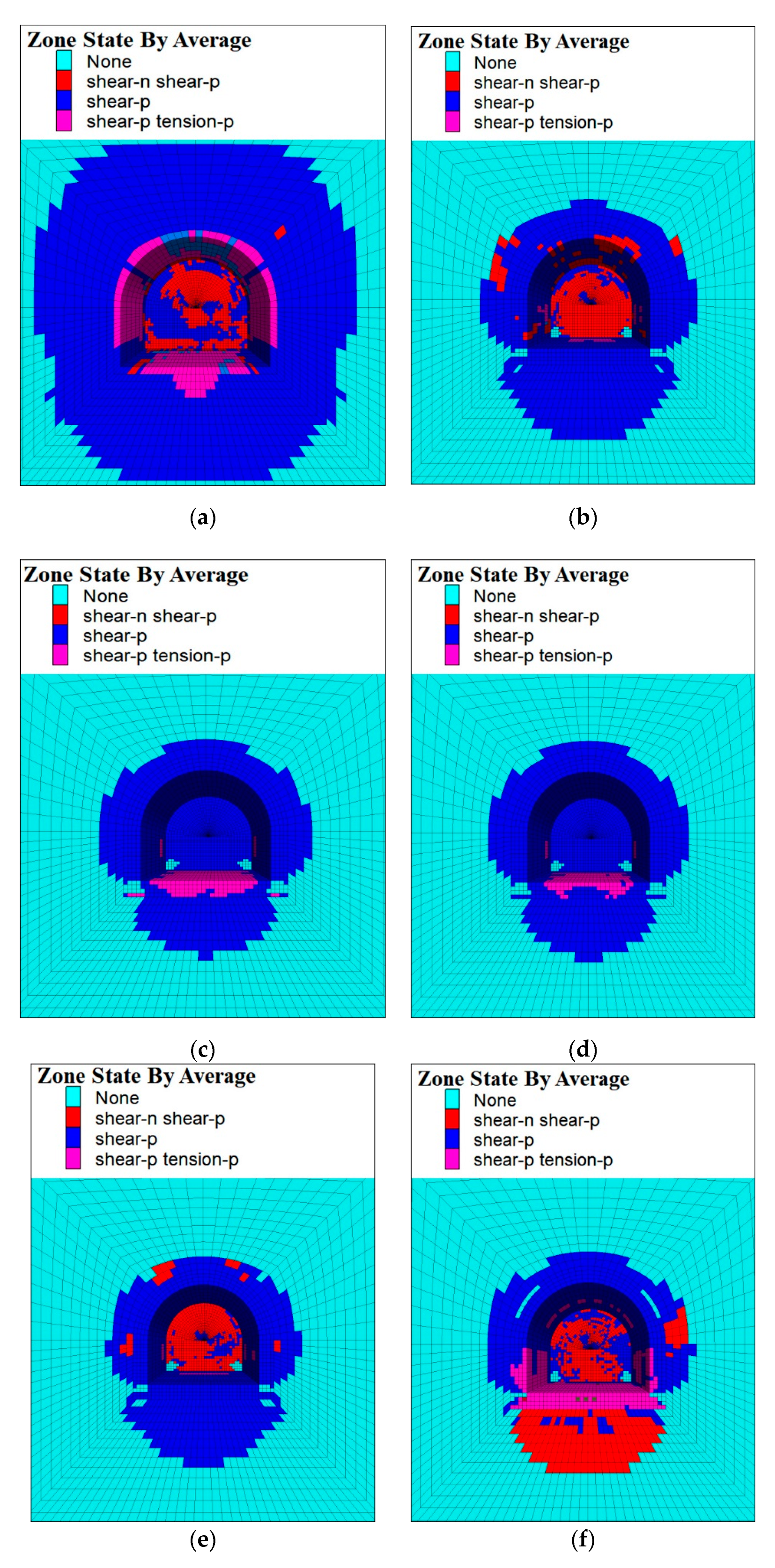
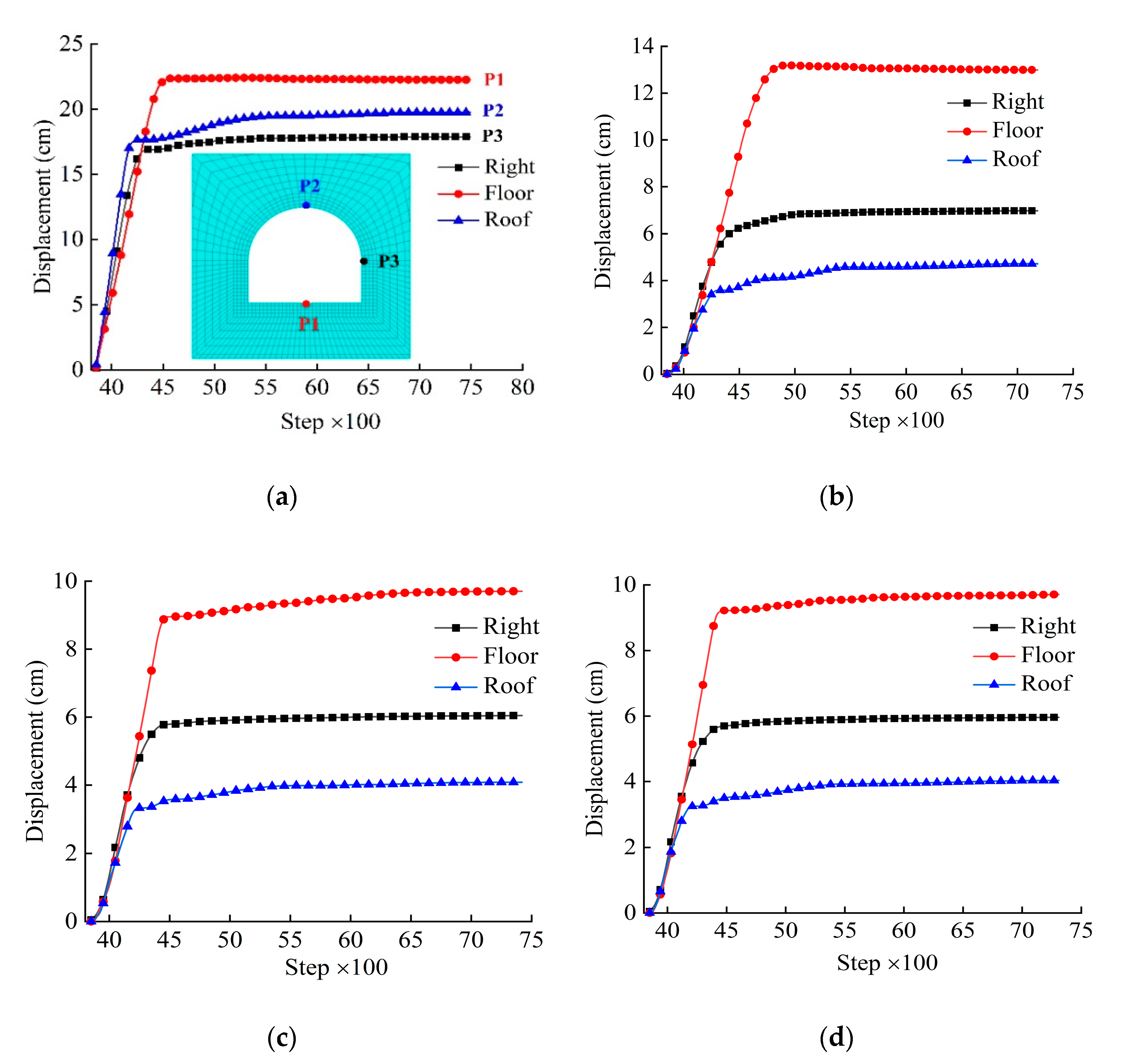
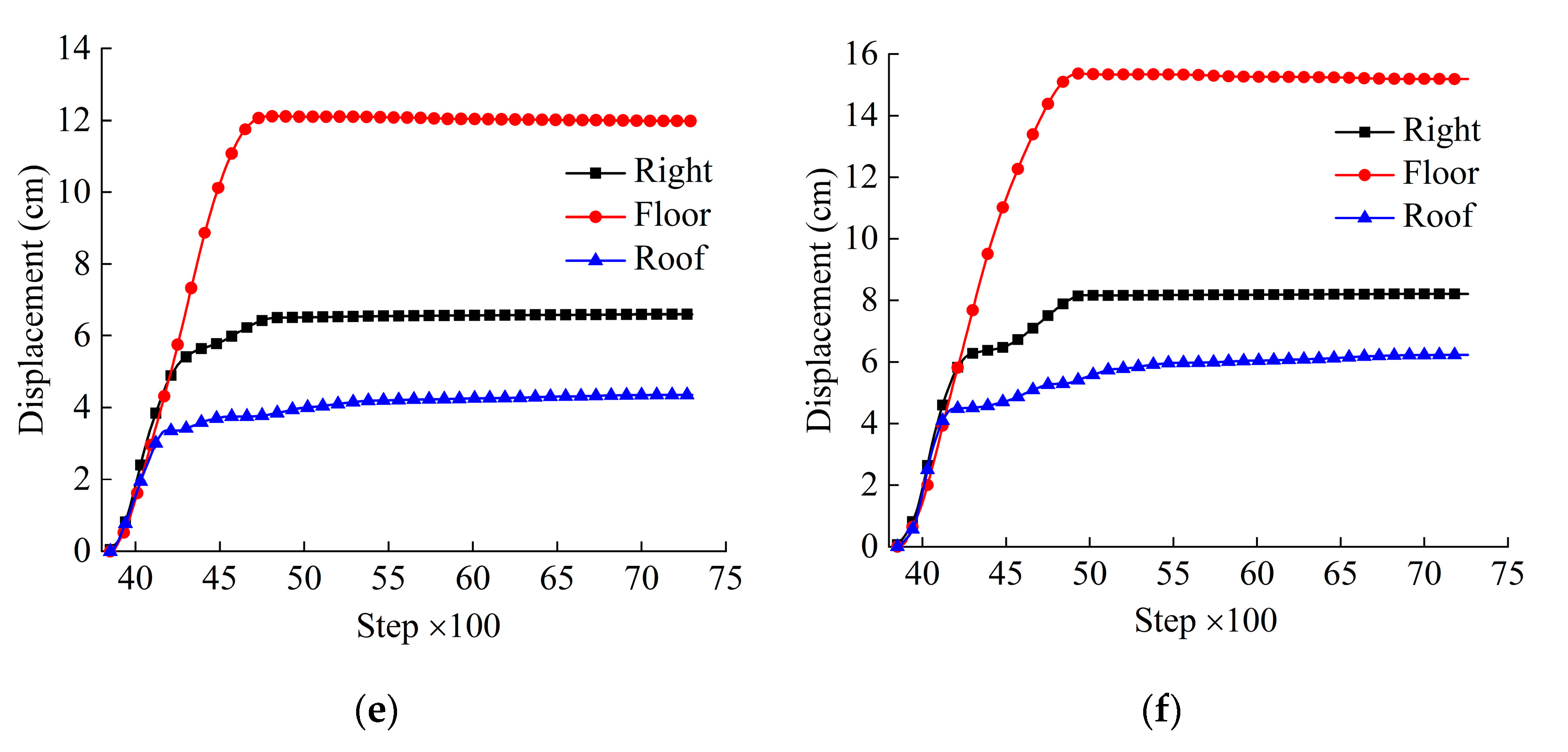

| Specific Surface Area (cm2·g−1) | Density (g·cm3) | Compressive Strength (MPa) | Bending Strength (MPa) | ||
|---|---|---|---|---|---|
| 3 Days | 28 Days | 3 Days | 28 Days | ||
| 3450 | 3.00 | 22.0 | 48.5 | 6.0 | 9.2 |
| Group | Rubber Particles (%) | Basalt Fibers (%) | Basalt Fiber (kg·m3) | Rubber Granular (kg·m3) | Cement (kg·m3) | River Sand (kg·m3) | Water (kg·m3) | Water Reducer (kg·m3) | Binder (kg·m3) | |
|---|---|---|---|---|---|---|---|---|---|---|
| A | A1 | 0% | 0 | 0 | 0 | 380 | 70 | 133 | 5.7 | 0 |
| A2 | 0.4% | 2.35 | 0 | 380 | 70 | 133 | 5.7 | 0 | ||
| A3 | 0.8% | 4.70 | 0 | 380 | 70 | 133 | 5.7 | 0 | ||
| A4 | 1.2% | 7.06 | 0 | 380 | 70 | 133 | 5.7 | 0 | ||
| B | B1 | 5% | 0 | 0 | 57.76 | 380 | 570 | 133 | 5.7 | 8.66 |
| B2 | 0.4% | 4.64 | 57.76 | 380 | 570 | 133 | 5.7 | 8.66 | ||
| B3 | 0.8% | 9.32 | 57.76 | 380 | 570 | 133 | 5.7 | 8.66 | ||
| B4 | 1.2% | 14.03 | 57.76 | 380 | 570 | 133 | 5.7 | 8.66 | ||
| C | C1 | 10% | 0 | 0 | 123.02 | 380 | 570 | 133 | 5.7 | 18.45 |
| C2 | 0.4% | 4.94 | 123.02 | 380 | 570 | 133 | 5.7 | 18.45 | ||
| C3 | 0.8% | 9.92 | 123.02 | 380 | 570 | 133 | 5.7 | 18.45 | ||
| C4 | 1.2% | 14.94 | 123.02 | 380 | 570 | 133 | 5.7 | 18.45 | ||
| D | D1 | 20% | 0 | 0 | 282.78 | 380 | 570 | 133 | 5.7 | 42.42 |
| D2 | 0.4% | 5.68 | 282.78 | 380 | 570 | 133 | 5.7 | 42.42 | ||
| D3 | 0.8% | 11.40 | 282.78 | 380 | 570 | 133 | 5.7 | 42.42 | ||
| D4 | 1.2% | 17.17 | 282.78 | 380 | 570 | 133 | 5.7 | 42.42 | ||
| E | E1 | 40% | 0 | 0 | 498.64 | 380 | 570 | 133 | 5.7 | 74.80 |
| E2 | 0.4% | 6.68 | 498.64 | 380 | 570 | 133 | 5.7 | 74.80 | ||
| E3 | 0.8% | 13.40 | 498.64 | 380 | 570 | 133 | 5.7 | 74.80 | ||
| E4 | 1.2% | 20.19 | 498.64 | 380 | 570 | 133 | 5.7 | 74.80 | ||
| Lithology | Elastic Modulus (GPa) | Poisson Ratio | Unit Weight (kN·m3) | Cohesion (MPa) | Friction Angle (°) | Tension (MPa) |
|---|---|---|---|---|---|---|
| Siltstone | 13.0 | 0.25 | 26.9 | 9.8 | 37 | 6.4 |
| Sandy mudstone | 4.50 | 0.30 | 26.1 | 1.9 | 30 | 2.45 |
| Mudstone | 1.12 | 0.22 | 22.9 | 0.58 | 32 | 1.2 |
| Material | Elastic Modulus (GPa) | Poisson Ratio | Cohesion (MPa) | Friction Angle (°) |
|---|---|---|---|---|
| A2 | 3.5 | 0.22 | 14.25 | 15 |
| B2 | 2.2 | 0.28 | 6.45 | 28 |
| C2 | 1.5 | 0.31 | 5.18 | 20 |
| D2 | 1.0 | 0.35 | 3.54 | 20 |
| PC | 4.3 | 0.20 | 3.02 | 45 |
| No. | Outer Rigid Supporting Materials | Internal Supporting Materials |
|---|---|---|
| Case 1 | / | / |
| Case 2 | PC | A2 |
| Case 3 | PC | B2 |
| Case 4 | PC | C2 |
| Case 5 | PC | D2 |
| Case 6 | PC | PC |
Publisher’s Note: MDPI stays neutral with regard to jurisdictional claims in published maps and institutional affiliations. |
© 2020 by the authors. Licensee MDPI, Basel, Switzerland. This article is an open access article distributed under the terms and conditions of the Creative Commons Attribution (CC BY) license (http://creativecommons.org/licenses/by/4.0/).
Share and Cite
Wu, D.; Li, Z.; Li, J.; Peng, B.; Shen, H. Study on Mechanical Properties of the Basalt Fiber-Rubber Granular Concrete under Triaxial Stress Condition and Its Application. Appl. Sci. 2020, 10, 8540. https://doi.org/10.3390/app10238540
Wu D, Li Z, Li J, Peng B, Shen H. Study on Mechanical Properties of the Basalt Fiber-Rubber Granular Concrete under Triaxial Stress Condition and Its Application. Applied Sciences. 2020; 10(23):8540. https://doi.org/10.3390/app10238540
Chicago/Turabian StyleWu, Duohua, Zhiwen Li, Juli Li, Bo Peng, and Hui Shen. 2020. "Study on Mechanical Properties of the Basalt Fiber-Rubber Granular Concrete under Triaxial Stress Condition and Its Application" Applied Sciences 10, no. 23: 8540. https://doi.org/10.3390/app10238540




